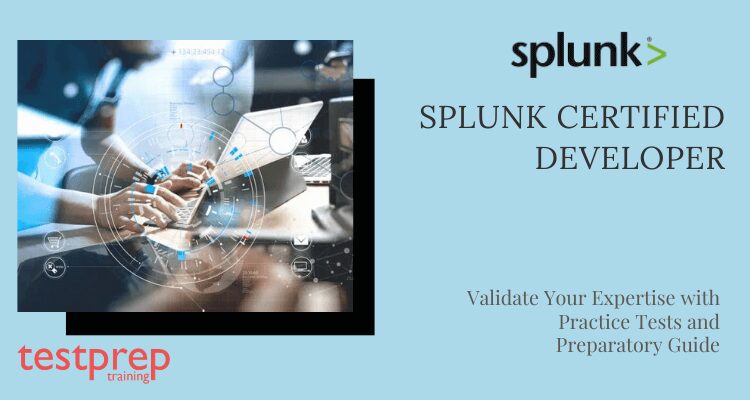Splunk Certified Developer

Splunk Certified Developer exam validates the candidate’s ability in optimizing productivity and writing code with any of the technology, language, framework, or method which the developer has hands-on. This examination assured that the candidates are best in providing accurate quality solutions, productive reports, and processing the available data.
Splunk Certified courses are designed to manage various components of Splunk Enterprise in which license management, indexers, search heads, configuration, monitoring, getting data into Splunk are included daily. It provides end to the end-user experience and is the first widely used big data tool. It also makes machine data accessible by recognizing data patterns, identifying problems, and provides quality to an organization.
Who should take the examination?
Splunk is an American Company so the people who are willing to mold their career in the direction of developers or CS/ IT industry and just waited for the opportunity then this examination certificate is best for them. Those candidates who have a deep interest in coding related frameworks then they can also apply for the examination.
Prerequisites for the Splunk Certified Developer exam
As a prerequisite of this examination, you must hold the Splunk Enterprise Certified Admin certification which includes advanced dashboards and visualization, building Splunk apps, developing with Splunk’s REST API. However, those candidates can register for the examination without any required restrictions.
Exam Details
| Exam Name: | Splunk Certified Developer |
| Exam Duration: | 57 minutes |
| Number of Questions: | 70 questions |
| Exam fee: | $125 |
| Language: | English |
For More Details See – FAQ | Splunk Certified Developer

Course Structure
The Splunk Certified Developer exam objectives covers the following domains:
Use Forms 5%
- Explain how tokens work
- Define types of token filters
Improve Performance 5%
- Use the stats command
- Use global searches
Customize Dashboards 5%
- Customize panel link buttons
- Set panel refresh and delay times
Use Event Handlers 5%
- Identify types of event handlers
- Describe event actions
Add Drilldowns 5%
- Define types of drill-downs
- Identify predefined tokens
Add Advanced Visualizations & Behaviors 5%
- Describe simple XML extensions
- Describe Splunk Custom Visualizations
Planning App Development 10%
- Describe ways to monitor app performance
- Identify useful Splunk log files
- Describe security best practices
Creating Apps 5%
- Define the app directory structure
- Describe app permissions
Adding Data 5%
- List types of data inputs
- Describe add-ons
Creating a KV Store 5%
- Define what is a KVK Store
- Describe KV Store lookup
- Create a KV Store collection
- Search a KV Store collection
- Update content in a VK Store collection
- Delete a KV Store collection
Packaging Apps 5%
- Describe the difference between local and default directories
Introduction to the Splunk REST API 5%
- Describe the REST URI format
- Identify which Splunk server to connect to (e.g., search head, indexer, forwarder)
- Identify where REST logging occurs
- Describe authentication methods
Namespaces and Object Management 10%
- Firstly, Describe namespaces and why they matter
- Secondly, Describe how the services NS is used with namespaces and REST endpoints
- Thirdly, Describe access control lists
- And Lastly, Update access control lists
Parsing REST Output 5%
- Firstly, Describe how the Splunk REST API uses Atom Syndication
- Secondly, Describe the entry element
- Thirdly, Describe the content element
- And lastly, Describe how to control the output format
Searching 10%
- Firstly, Describe the importance of specifying fields in a search
- Secondly, Describe options for specifying a search time range
- Thirdly, Describe blocking, one-shot, normal, and export searches
- Further, Describe search jobs
- Then, Create and manage search jobs
- Also, Describe ways to improve search performances
- Furthermore, Identify some options that are available when creating an index
- Create and manage indexes
- Further, Describe the Splunk HTTP Event Collector (HEC)
- Also, Describe HEC tokens and how they are used
- Describe indexer acknowledgment
- Lastly, Create and use HEC tokens to get data into Splunk
Writing Data to Splunk 10%
- Identify some options that are available when creating an index
- Create and manage indexes
- Describe the Splunk HTTP Event Collector (HEC)
- Explain HEC tokens and how they are used
- Describe indexer acknowledgment
- Create and use HEC tokens to get data into Splunk
Registration Process
- Select “create account” on the Splunk Landing Page.
- Enter your email address and your basic demographic information such as name, address, number, etc.
- Go to the Splunk page
- Sign in to the account
- Choose your exam
- Schedule a date and time for testing
- Complete payment procedure
Preparatory Guide: Splunk Certified Developer
Earning an industry-recognized certification can be a challenging task, especially if you are new to that particular field. While some prefer taking the digital mode of learning, others rely on the course books to gain knowledge to crack the Splunk Certified Developer certification exam. The choice is completely yours. However, one thing that remains very important is the authenticity of the study material. Collecting suitable study resources can be a tedious task. So, to ease your preparation journey, we have assembled below, a list of all the recommended study resources, to help you gain command of the fields in which you’ll be examined during the exam.

Official Study Guide
The first and most important step is to download the official study guide from the Splunk website. The study guide will bring forward all the essential information that you need in order to start preparing yourself to become a Splunk Certified Developer. The exam objectives listed in the guide will let you identify the different areas in which you will be examined. Moreover, it acts as a Splunk Certified Developer blueprint and will help you manage your time once your start studying.
Recommended Courses
Splunk recommends the candidates taking the Splunk Certified Developer exam, take a few courses, to help them enhance their skills. These Splunk Certified Developer training courses are specially designed for the ones who want to nurture their skills in builds apps using the Splunk Web Framework. These courses are listed below –
Advanced Dashboards and Visualizations
Splunk offers this course for advanced users to learn more about creating Splunk JS-based dashboards and forms. The duration of the course is one day, so you must take up this course if you are serious about the certification. Following are the topics covered in this course –
- Splunk JS Dashboards
- Using Tokens
- Using Event Handlers
- Creating Custom Visualizations
Building Splunk Apps
This course is primarily aimed at increasing the candidates’ practical expertise in the Splunk app development. This 2-day course is prepared for advanced users, administrators, and developers. Following are the topics covered in this course –
- Planning App Development
- Adding Data
- Creating Apps
- Creating a KV Store
- Using the Splunk REST API
- Packaging Apps
Developing with Splunk’s REST API
This course will help you learn about the application of Splunk’s REST API in accomplishing the tasks on a Splunk server. Also, you’ll learn about the use of curl and Python in sending requests to Splunk REST endpoints and will also learn how you must parse the results. Following are the topics covered in this 9-hour course –
- Introduction to the Splunk REST API
- Namespaces and Object Management
- Parsing Output
- One-shot Searching
- Normal and Export Searching
- Advanced Searching and Job Management
- Working with Indexes
- Using the HTTP Event Collector
Take Practice Tests
To identify the loopholes in your preparation, practice tests are the most reliable way. Taking a sufficient number of practice tests familiarizes us with the format of the exam, along with enabling us to handle the tricky and difficult part of the exams as well. Splunk Certified Developer practice tests help in increasing our confidence and making us exam-ready. Moreover, practice test helps us to achieve mental alertness which is necessary during such advanced level certification exams.

